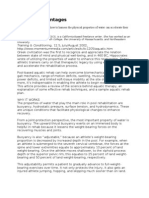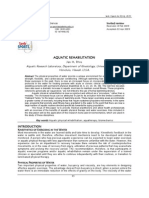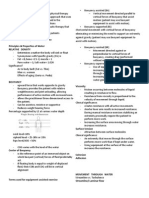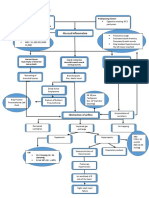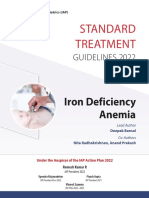Aktiviti Latihan Terapi Air
Aktiviti Latihan Terapi Air
Uploaded by
as-suhairiCopyright:
Available Formats
Aktiviti Latihan Terapi Air
Aktiviti Latihan Terapi Air
Uploaded by
as-suhairiOriginal Description:
Copyright
Available Formats
Share this document
Did you find this document useful?
Is this content inappropriate?
Copyright:
Available Formats
Aktiviti Latihan Terapi Air
Aktiviti Latihan Terapi Air
Uploaded by
as-suhairiCopyright:
Available Formats
Water-Based Therapy for Exercise
By: Andrew J. Cole, MD The techniques used in water therapy exercise for back pain include spa therapy, standing or floating pool exercises, swimming, and conditioning using specialized equipment, such as surgical tubing, flotation devices and resistive devices for the hands or feet. Spa treatments complementing water therapy back exercise typically involve relaxing in warm, agitated water such as that found in whirlpool baths. This form of hydrotherapy relaxes muscles, improved muscle blood flow and increases general blood circulation, which make the body more flexible and can prepare it for water therapy or land-based exercise. Article continues below Active techniques for water therapy back exercise are diverse and should be tailored to the individual. Exercises range from simple routines performed in a shallow pool to conditioning using underwater treadmills and other high-tech equipment.
Water therapy exercises muscles and joints, as well as the back
Some of the basic techniques for pool therapy exercises are as follows (they can be modified for varying degrees of difficulty):
Knee-to-chest exercise. This movement is performed with one hand on the side of the pool or with back to the wall. Alternating between legs stretches the lower back, as well as the gluteus (buttocks), quadriceps (front thigh) and hamstring (back thigh) muscles. Leg raise exercise. This movement is performed with one leg outstretched and the supporting leg slightly bent while one hand holds onto the side of the pool. It strengthens and stretches the muscles in the leg, hip and lower back. Wall-facing leg stretch exercise. In this stretching exercise individuals assume a Superman position with hands resting on side of pool and the body and legs outstretched into and supported by water. This extends all regions of and joints in the back as well as stretching shoulder muscles. Pool walking exercise. Walking both forward and backward in chest-high water works the leg muscles while exerting no impact of the knees or hips, particularly important for people who have arthritis in those joints. The walking exercise can be made more demanding with the addition of hand floats or light weights, so a stroll in the pool becomes an aquatic version of power walking. Quadruped activity and exercise. This exercise works legs and arms and is performed while floating on ones back (sometimes achieved with a therapist
supporting the trunk or using a flotation jacket). The individual makes paddling motions with his/her arms and legs.
Combined water therapy for back exercise with landbased methods
Water therapy for back exercise can be a short-term exercise option if back pain or a back injury makes land-based exercise too difficult. Or it can be adopted as part of an ongoing exercise program if land-based methods worsen symptoms or if the person prefers water exercises. If their functional status or competitive goals require it, people may transition to exercise in a dry environment once they are successfully performing exercises in water. Some people may find mixed use of wet and dry exercise therapy environments most beneficial. There is a small but growing body of scientific studies demonstrating the benefits of aquatic exercise in the management of spine pain. Although more scientific evidence for the specific benefits of water therapy exercise in treating back pain will be helpful in creating specific programs for particular spine problems, the value of appropriate aquatic exercise programs is well established overall and has been beneficial in many thousands of individuals. The aquatic medium is ideal for patients for whom land-based options for back exercise are limited, and may provide a safe and effective method of managing spine pain while improving function.
You might also like
- Pediatric Endocrine Protocols-1Document231 pagesPediatric Endocrine Protocols-1Ananya Sampath100% (2)
- Aquatic Exercises For Rehabilitation and TrainingDocument12 pagesAquatic Exercises For Rehabilitation and Trainingmaham Yousuf100% (2)
- Sport AAOS MCQ 2019Document155 pagesSport AAOS MCQ 2019Gajendra ShahNo ratings yet
- Respiratory DysfunctionDocument1 pageRespiratory Dysfunctionoxidalaj100% (3)
- Water Therapy Exercise ProgramDocument4 pagesWater Therapy Exercise Programrenee_soong127100% (1)
- Aquatic AdvantagesDocument7 pagesAquatic AdvantagesGhita Marius GeorgeNo ratings yet
- Aquatic TherapyDocument37 pagesAquatic TherapyMustafa Mabrouk100% (1)
- Make the Pool Your Gym: No-Impact Water Workouts for Getting Fit, Building Strength and Rehabbing from InjuryFrom EverandMake the Pool Your Gym: No-Impact Water Workouts for Getting Fit, Building Strength and Rehabbing from InjuryRating: 5 out of 5 stars5/5 (1)
- Make the Pool Your Gym, 2nd Edition: No-Impact Water Workouts for Getting Fit, Building Strength and Rehabbing from InjuryFrom EverandMake the Pool Your Gym, 2nd Edition: No-Impact Water Workouts for Getting Fit, Building Strength and Rehabbing from InjuryNo ratings yet
- Exercise and ObesityDocument2 pagesExercise and ObesityLivingFitNo ratings yet
- Aquatic RehabilitationDocument8 pagesAquatic RehabilitationFlorentina MocanuNo ratings yet
- Hydrotherapy by Abdul Ghafoor Sajjad Physiotherapist AFIRMDocument4 pagesHydrotherapy by Abdul Ghafoor Sajjad Physiotherapist AFIRMAbdul Ghafoor SajjadNo ratings yet
- Aquaticexercises 141130033308 Conversion Gate02Document36 pagesAquaticexercises 141130033308 Conversion Gate02Dolly Joy Bautista AsuncionNo ratings yet
- Aquatic ExercisesDocument36 pagesAquatic ExercisesgialinuNo ratings yet
- HydrotherapyDocument14 pagesHydrotherapyKumaravel MuruganNo ratings yet
- AquaticExerciseDocument25 pagesAquaticExercisegialinu100% (1)
- Anatomy: The Ligaments of The Knee JointDocument5 pagesAnatomy: The Ligaments of The Knee JointhumeraNo ratings yet
- Swimming&gym StudyDocument11 pagesSwimming&gym Studyg5d74thrdyNo ratings yet
- Acuatic Therapy - HandoutDocument6 pagesAcuatic Therapy - HandoutKarthikeyan Guru100% (1)
- Aquatic Exercise TherapyDocument3 pagesAquatic Exercise TherapyClang Tejada100% (1)
- Bad Ragaz Ring MethodDocument22 pagesBad Ragaz Ring MethodNurdina Afini0% (1)
- PEH 4 AQUATICSsDocument7 pagesPEH 4 AQUATICSsCharmaine PearlNo ratings yet
- Therapeutic Swimming: Teacher: Anca Pop and Sturzu Bogdan Student:Benea Adrian DanielDocument10 pagesTherapeutic Swimming: Teacher: Anca Pop and Sturzu Bogdan Student:Benea Adrian DanielRubenNo ratings yet
- Guidelines For Giving Enema: HydrotherapyDocument3 pagesGuidelines For Giving Enema: HydrotherapyDeboo X XavierNo ratings yet
- Aquatic TherapyDocument2 pagesAquatic Therapyonix2000No ratings yet
- Physical ConditioningDocument19 pagesPhysical ConditioningFranchesqa Myluck SamonteNo ratings yet
- Hydrotherapy Principles & TechniquesDocument75 pagesHydrotherapy Principles & TechniquesSANLAPAN SAHOONo ratings yet
- Water Aerobics Is A Type of Aerobic ExerciseDocument12 pagesWater Aerobics Is A Type of Aerobic ExercisePete MagaleNo ratings yet
- Aquatic-Based Rehabilitation and Training For The ShoulderDocument8 pagesAquatic-Based Rehabilitation and Training For The ShoulderNickravesh Masouleh SajadNo ratings yet
- What Is Aquatic Fitness (PDF) (PDF) - 201406250803534554Document6 pagesWhat Is Aquatic Fitness (PDF) (PDF) - 201406250803534554Robin TandalaNo ratings yet
- SwimmingDocument4 pagesSwimmingNeighvestNo ratings yet
- Midterm - 7 POOL TherapyDocument67 pagesMidterm - 7 POOL TherapyYvana Dela CruzNo ratings yet
- What Is Aquatic TherapyDocument5 pagesWhat Is Aquatic TherapyHaslindaNo ratings yet
- Speaking TgsDocument2 pagesSpeaking TgsJessica Surya DNo ratings yet
- DYNAMIC LUMBAR STABILIZATION TRAINING Dean Farwood, P.T.Document5 pagesDYNAMIC LUMBAR STABILIZATION TRAINING Dean Farwood, P.T.Luis Eduardo Barbosa OrtegaNo ratings yet
- Swimming BenefitsDocument3 pagesSwimming BenefitsankithdukkuNo ratings yet
- The Benefits of Aquatic Therapy BADESCU ARTICOLDocument10 pagesThe Benefits of Aquatic Therapy BADESCU ARTICOLGiorgos KatsisNo ratings yet
- Aquatic Physical Therapy: Thomas Cesarz and David SpeachDocument2 pagesAquatic Physical Therapy: Thomas Cesarz and David SpeachMaria P12No ratings yet
- Aquatic Therapy and RebabilitationDocument20 pagesAquatic Therapy and RebabilitationLeonardiniNo ratings yet
- Aquaneuro DesignDocument7 pagesAquaneuro DesignPau BernardoNo ratings yet
- Aquatic Exercise: Syed Amjad HussainDocument15 pagesAquatic Exercise: Syed Amjad HussainMAAZ AMEENNo ratings yet
- Water Aerobics: Areas It TargetsDocument3 pagesWater Aerobics: Areas It Targetsedward mirandilla miranda jr.No ratings yet
- Aquatic ActivitiesDocument21 pagesAquatic ActivitiesJames Baryl GarceloNo ratings yet
- Aqua TherapyDocument19 pagesAqua TherapyNestor Balboa100% (1)
- BloopDocument20 pagesBloopsundar persaudNo ratings yet
- Trunk Stabilization ProgramDocument20 pagesTrunk Stabilization ProgramLate ArtistNo ratings yet
- Aquatics: Prepared By: Allan D. ArlosDocument21 pagesAquatics: Prepared By: Allan D. ArlosMarc Ian Dela PeñaNo ratings yet
- Introduction To Aquatics: L E S S O NDocument12 pagesIntroduction To Aquatics: L E S S O Njerold cedronNo ratings yet
- Water Aerobics: The Ultimate Guide on How to Lose Weight Fast, Increase Flexibility, tone the body and Correct Bad Posture in the WaterFrom EverandWater Aerobics: The Ultimate Guide on How to Lose Weight Fast, Increase Flexibility, tone the body and Correct Bad Posture in the WaterRating: 3 out of 5 stars3/5 (1)
- HOPE 12 Hand OutsDocument2 pagesHOPE 12 Hand OutssanidadfamilynetflixNo ratings yet
- Electrotherapy 1Document3 pagesElectrotherapy 1Captain AmericaNo ratings yet
- Training Principles and Fitt FormulaDocument7 pagesTraining Principles and Fitt FormulaChizon SalomonNo ratings yet
- Impact of Aquatic InterventionsDocument28 pagesImpact of Aquatic InterventionsKhaled Hussein YoussefNo ratings yet
- Activity 2Document6 pagesActivity 2Christine Joy LealNo ratings yet
- Exercise and SclerodermaDocument22 pagesExercise and SclerodermaLupin TohNo ratings yet
- Benefits of SwimmingDocument3 pagesBenefits of SwimmingMildred VillarubiaNo ratings yet
- Aqua 2Document267 pagesAqua 2ck100% (3)
- Bagua Rolling Step MethodDocument4 pagesBagua Rolling Step MethodRamon CastellanosNo ratings yet
- Aquatic Therapy: Exercising in WaterDocument2 pagesAquatic Therapy: Exercising in WaterdivermedicNo ratings yet
- Physio Booklet WebDocument28 pagesPhysio Booklet Webআশিকুজ্জামানআশিকNo ratings yet
- Aquatic Therapy Services in Women HealthDocument21 pagesAquatic Therapy Services in Women HealthMohammad Ajmal Madni100% (1)
- Adm Peh12 w2Document16 pagesAdm Peh12 w2ALkyendi IndasanNo ratings yet
- Parvina and Su Lin Are Best Friends They Always Go To School Together One Day Parvina Was Late She Was So UnhappyDocument3 pagesParvina and Su Lin Are Best Friends They Always Go To School Together One Day Parvina Was Late She Was So Unhappyas-suhairiNo ratings yet
- Whisk The Yoghurt Sugar and Honey in A Bowl Pour All The Ingredients in An Ice Cream Maker Freeze The Yoghurt in The Freezer Top The Yoghurt With StrawberriesDocument4 pagesWhisk The Yoghurt Sugar and Honey in A Bowl Pour All The Ingredients in An Ice Cream Maker Freeze The Yoghurt in The Freezer Top The Yoghurt With Strawberriesas-suhairiNo ratings yet
- RPT KSSRPK - BP - Bi T1Document14 pagesRPT KSSRPK - BP - Bi T1as-suhairiNo ratings yet
- 1a-Pgsr-Format Jadual RajahDocument1 page1a-Pgsr-Format Jadual Rajahas-suhairiNo ratings yet
- Bol I EutanazijaDocument6 pagesBol I EutanazijaanarbvukNo ratings yet
- Tumor MarkersDocument14 pagesTumor MarkersPatrick LizarondoNo ratings yet
- COPD PathophysioDocument1 pageCOPD Pathophysionanette flores dela cruzNo ratings yet
- AOGD Bulletin October 2020Document68 pagesAOGD Bulletin October 2020abdelrazag T GhadbanNo ratings yet
- Drug StudyDocument2 pagesDrug Studykym_estrellaNo ratings yet
- Med Surg Week 6Document11 pagesMed Surg Week 6Eunice Cortés100% (1)
- Gynecological ProblemDocument40 pagesGynecological Problemannu panchalNo ratings yet
- RNSG 1533 Exam 3 Study Guide Instructor Key Elimination Fill in The Blank and Short AnswerDocument11 pagesRNSG 1533 Exam 3 Study Guide Instructor Key Elimination Fill in The Blank and Short AnswerMaica LectanaNo ratings yet
- Pediatric RadiotherapyDocument365 pagesPediatric RadiotherapyMadalina-Elena Costache100% (1)
- Cesarean Section FinalDocument36 pagesCesarean Section FinalCuttie Anne GalangNo ratings yet
- Limfoma de BurkittDocument8 pagesLimfoma de BurkittJesús Cortés HernándezNo ratings yet
- MEDORRHINUMThe Gonorrhśal VirusDocument60 pagesMEDORRHINUMThe Gonorrhśal Virusfausto omio100% (1)
- Quiz 1 Chapters 1 and 2 - Revisión Del Intento - Centro de Aprendizaje de Lenguas USACDocument13 pagesQuiz 1 Chapters 1 and 2 - Revisión Del Intento - Centro de Aprendizaje de Lenguas USACjulia floresNo ratings yet
- Congenital HydroceleDocument1 pageCongenital HydroceleVedant KumarNo ratings yet
- Rabies BrochureDocument2 pagesRabies Brochureselvie87No ratings yet
- Event-Based Surveillance and ResponseDocument27 pagesEvent-Based Surveillance and ResponseNovelyn MalaluanNo ratings yet
- CH 059 STG Iron Deficiency AnemiaDocument8 pagesCH 059 STG Iron Deficiency AnemiaRashmi DandriyalNo ratings yet
- Name: - Score: - Year and SectionDocument12 pagesName: - Score: - Year and SectionSteve EstebanNo ratings yet
- Prepare Drug Profile of Aspirin: 1. Product DescriptionDocument11 pagesPrepare Drug Profile of Aspirin: 1. Product DescriptionUmna QureshiNo ratings yet
- Lab DataDocument63 pagesLab Datab202104023 TMUNo ratings yet
- Behavioral FinalsDocument28 pagesBehavioral FinalsKofiBNo ratings yet
- This Study Resource Was Shared Via: Nursing Care Plan FormDocument3 pagesThis Study Resource Was Shared Via: Nursing Care Plan FormissaiahnicolleNo ratings yet
- Consensus Report: Periodontic-Endodontic Lesions: Group MembersDocument2 pagesConsensus Report: Periodontic-Endodontic Lesions: Group MembersAlex Grande CancapaNo ratings yet
- Electro Encephalo Graphy FinalDocument7 pagesElectro Encephalo Graphy FinalShubhrima KhanNo ratings yet
- Journal Reading Kulit OkDocument4 pagesJournal Reading Kulit OkNida Fithria FadhilaNo ratings yet
- 间歇性断食Document6 pages间歇性断食miya0219hNo ratings yet
- MS Radiation & Medical Oncology Course ContentsDocument8 pagesMS Radiation & Medical Oncology Course ContentsAtih_Ul_Haq_5No ratings yet





